Scientists believe that Maldive Islands were first settled by Aryan immigrants who are thought to have colonised Sri Lanka at the same time, (around 500 BC). Further migration from South India, as well as Sri Lanka, occurred. The latest archaeological findings suggest the islands were inhabited as early as 1500 BC. Around 947 AD, recorded contact with the outside world began with the first Arab travellers. As the population increased, the Maldivian people with their mixed features formed tight-knit island communities. Historical remains dating back to 400 BC show strong evidence that Buddhism was widely practised among the people. Islam came to the Maldives with the Persian and Arab travellers and in 1153 AD Arabian traveller Abul Barakhat Al-Bar Bari is said to have been responsible for the conversion to Islam. In 1558, the Portuguese invaded and captured the Maldives. They ruled the country for 15 years, until Boduthakurufaanu, the national hero recaptured the Maldives from the Portuguese. He ruled the country as Sultan Mohamed Thakurufaanu from 1573 – 1583.
The Maldives became a British Protectorate and a dependency of Ceylon (Sri Lanka) in 1887 and remained so until 26 July 1965 when they gained full independence. The independent Maldives reverted from a Sultanate to a Republic on 11th November 1968 and since then the country has remained a fully independent republic.
The first resort, Kurumba Village was developed in 1972, on an uninhabited island near the capital, Malé. The resort, had accommodation for about 60 guests. The second resort was Bandos, with about 280 beds. The services in the two resorts were quite basic compared to that of others in the region. The food was mainly local and the transportation quite slow. It was also a time when air travel to the Maldives was only available on Air Ceylon which operated a small Avero aircraft. This plane carried only 48 passengers and took two hours to reach Malé from Colombo. Despite this, over a thousand tourists came to the Maldives in 1972. In 2003 the Maldives consists of more than 80 resorts, and over 500,000 visitors from all over the world. Italian visitors account for approximately 25% of all visitors, followed by the UK at 17%, Germany at 14% and Japan at 9% and the average stay is 8.5 nights.
The Maldives hold the record for being the flattest country in the world, with a maximum altitude of only 2.3 metres. Although there have been reports of rising sea levels threatening the islands, the sea level has actually lowered in recent decades. There are said to be 199 inhabited islands and 993 uninhabited islands.
The December tsunami reached the Maldives at approximately 9.20am on 26 December 2004, sending waves up to five metres high over the 1192 islands. The disaster is believed to have caused damage to 69 of the 199 inhabited islands and 14 islands are said to be completely devastated and had to be evacuated. In total, some 20,500 islanders were displaced from their homes and 83 people were killed, including three tourists. A further 25 people are still missing and presumed lost in the disaster.
Even before the disaster, environmentalists were concerned about the risk to the islands from rising sea levels. The most serious damage was to the islands along the east coast of the group, particularly in North Malé Atoll and South Malé Atoll, but the capital, Malé, and the international airport on Hulhule island experienced only minor flooding. The tsunami also caused significant damage in the far south of the Maldives, particularly to Vilufushi in the Thaa Atoll and Kolhufushi in the Meemu Atoll. In the north, Kandholhudhoo island in the Raa Atoll was completely destroyed, displacing 3,000 islanders from their homes. The island has since been abandoned. Cartographers are planning to redraw the maps of the islands due to alterations by the tsunami.
Despite the massive damage to homes, schools, harbour facilities, telephone and electricity suppliers and general infrastructure, the loss of life was thankfully comparatively small, especially when compared with Indonesia, Sri Lanka, India and Thailand. Still, estimates suggest that around 7% of the population has been left homeless by the disaster and the overall cost of damage is estimated at US$470 million, or 62% of the islands' GDP. The government has reported that the impact of the tsunami will set back development in the Maldives by two decades.
Despite this, the emergency relief effort has been extremely successful, though some would say that it has been challenged to the areas most frequented by tourists. As of March, 71 of the 87 resorts in the Maldives were open as normal and tourists could visit Malé and other areas that escaped major damage without problems. However, 16 resorts remain closed as a result of the disaster – for an update on the 16 hotels that are closed, see: www.visitmaldives.com.mv
No prior visa arrangements are required, but some requirements must be fulfilled to obtain a 30 days tourist visa on arrival: a visitor must have a valid travel documents and properly completed embarkation/disembarkation cards which usually provided at during the inward flight. In addition, visitors must also have a return air ticket or at least US$ 50.00 per intended day of stay in Maldives. Any amount of Foreign currency can be brought in without declaring and can be taken out without any restriction. Some items are forbidden to be imported to the country, including firearms and explosives, pornography of any kind, including what would be considered “acceptable erotica” in all western (and most eastern) societies, pork and all products containing pork, narcotic drugs, poisons and hazardous, irritable or industrial chemicals and alcohol. Alcoholic items purchased on the trip will be held in Customs bond for collection upon departure.
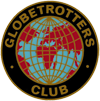
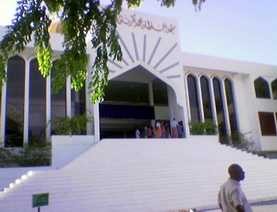
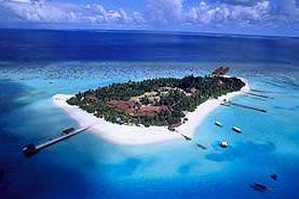
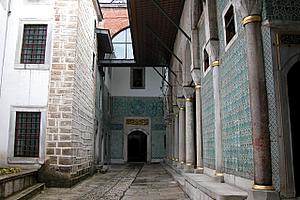
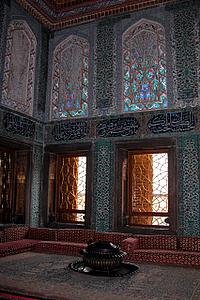

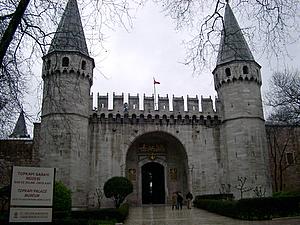
 We are sorry to say that Mac is not very well, but he is still
e-mailing strong and recently sent the Beetle a collection of
travel reminiscences about Japan and shopping in Hong Kong.
We are sorry to say that Mac is not very well, but he is still
e-mailing strong and recently sent the Beetle a collection of
travel reminiscences about Japan and shopping in Hong Kong.





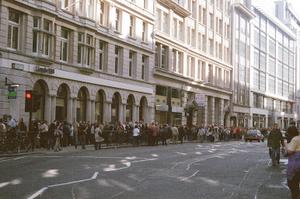 So, instead, we went to the Bank of England and we
joined a guided tour there. It was excellent! Believe it or not,
the site of the Bank of England, which has been located in
Threadneedle Street since 1734, covers a massive 3 ½ acres – who
would have thought it! We moved down a very majestic staircase
to some beautiful state rooms downstairs and through the
gardens and up again to the rooms that are used to hold meetings
with visiting officials to discuss monetary policy. The tour ended
in the Bank's museum which is fascinating and includes a gold
bullion bar, encased in bullet proof glass, of course, which
Padmassana had a go at lifting through the specially designed hole
for people to touch the bar. You can visit the museum any time and
it is free of charge. The museum is open Monday to Friday, 10.00 –
17.00, Christmas Eve, 10.00 – 13.00 but is closed at weekends and
on Public and Bank Holidays.
So, instead, we went to the Bank of England and we
joined a guided tour there. It was excellent! Believe it or not,
the site of the Bank of England, which has been located in
Threadneedle Street since 1734, covers a massive 3 ½ acres – who
would have thought it! We moved down a very majestic staircase
to some beautiful state rooms downstairs and through the
gardens and up again to the rooms that are used to hold meetings
with visiting officials to discuss monetary policy. The tour ended
in the Bank's museum which is fascinating and includes a gold
bullion bar, encased in bullet proof glass, of course, which
Padmassana had a go at lifting through the specially designed hole
for people to touch the bar. You can visit the museum any time and
it is free of charge. The museum is open Monday to Friday, 10.00 –
17.00, Christmas Eve, 10.00 – 13.00 but is closed at weekends and
on Public and Bank Holidays.
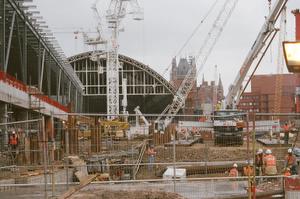 After the Bank of England tour, we visited one of the
livery companies near Smithfield market and after a fry up at the
Beetle's favourite 24/7 greasy spoon café, we headed up to St
Pancras and joined a tour run by Arups, the consulting engineers
responsible for building the new ST Pancras train staton which is
to be the new home of the Eurostar as well as a new and upgraded
train station for regional trains.
After the Bank of England tour, we visited one of the
livery companies near Smithfield market and after a fry up at the
Beetle's favourite 24/7 greasy spoon café, we headed up to St
Pancras and joined a tour run by Arups, the consulting engineers
responsible for building the new ST Pancras train staton which is
to be the new home of the Eurostar as well as a new and upgraded
train station for regional trains.
 Mistake, mistake, mistake – How could I have made such a stupid
mistake. At our late lunch stop I had changed from boots to
sandals, strong sandals, the problem was not with the footwear but
with my brain which seemed to have gone into non thinking mode as
the day started to turn to twilight. We had been walking fast,
through thick rain forest and crossing and re-crossing rivers or
maybe even the same river. The last few Kilometres of the twenty
seven from our jump into the jungle to the 'Yawanawa'
village, our guides had decided to make what was a two day trek
into one. Why? I have no idea, unless it was too see how we would
make out. My legs felt like lead pillars as I walked in the river
my sandals acting like buckets holding my down feet, like walking
in treacle, my heart pounded loudly with each stride as I tried to
keep up with 'Yawanawa' Indian ahead, who was starting to
disappear in the dusk. The tribe had warned us that the rain forest
was very dangerous at night and they would always be back in the
village by nightfall! Just as I thought I could go no further and
dusk started to turn to darkness, I saw a figure on the shore about
a hundred metres away waving me on. I staggered up to Adam Baines,
for that's who it was, as he said “Well done Tony we have
made it” and we shook hands. Months of politicking in the
urban jungle, then many adventures on the way to our final
destination, the 'Yawanawa' village of Novo Esperanca – At
last we had arrived or nearly, the last hurdle or just about the
last straw, was about seventy steps cut in to the steep river bank
leading up to the village.
Mistake, mistake, mistake – How could I have made such a stupid
mistake. At our late lunch stop I had changed from boots to
sandals, strong sandals, the problem was not with the footwear but
with my brain which seemed to have gone into non thinking mode as
the day started to turn to twilight. We had been walking fast,
through thick rain forest and crossing and re-crossing rivers or
maybe even the same river. The last few Kilometres of the twenty
seven from our jump into the jungle to the 'Yawanawa'
village, our guides had decided to make what was a two day trek
into one. Why? I have no idea, unless it was too see how we would
make out. My legs felt like lead pillars as I walked in the river
my sandals acting like buckets holding my down feet, like walking
in treacle, my heart pounded loudly with each stride as I tried to
keep up with 'Yawanawa' Indian ahead, who was starting to
disappear in the dusk. The tribe had warned us that the rain forest
was very dangerous at night and they would always be back in the
village by nightfall! Just as I thought I could go no further and
dusk started to turn to darkness, I saw a figure on the shore about
a hundred metres away waving me on. I staggered up to Adam Baines,
for that's who it was, as he said “Well done Tony we have
made it” and we shook hands. Months of politicking in the
urban jungle, then many adventures on the way to our final
destination, the 'Yawanawa' village of Novo Esperanca – At
last we had arrived or nearly, the last hurdle or just about the
last straw, was about seventy steps cut in to the steep river bank
leading up to the village.
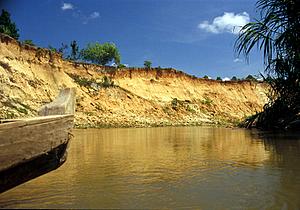 The 'Yawanawa' were early risers, the queue for the
bathroom or in this case the river started at 0415 hours for the
women and then the men from about 0445 hours. Breakfast consisted
of something from the day before, usually highly salted and
difficult to keep down as the sun started to kiss the village roofs
of the 'Yawanawa'.
The 'Yawanawa' were early risers, the queue for the
bathroom or in this case the river started at 0415 hours for the
women and then the men from about 0445 hours. Breakfast consisted
of something from the day before, usually highly salted and
difficult to keep down as the sun started to kiss the village roofs
of the 'Yawanawa'.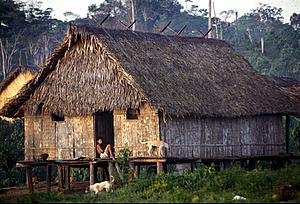 We had a
special treat one night, when the chief switched the fridge on for
a couple of hours and we had a mug of cold water that tasted as
good as any cold beer I have ever tasted.
We had a
special treat one night, when the chief switched the fridge on for
a couple of hours and we had a mug of cold water that tasted as
good as any cold beer I have ever tasted.
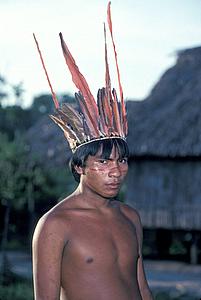 These Indigenous people had five different ways of sustaining
themselves,' in the depth of this green paradise.
These Indigenous people had five different ways of sustaining
themselves,' in the depth of this green paradise.
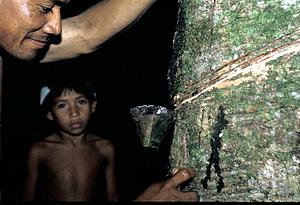 The two ways they made some money was with 'Aveda', a
Canadian firm that bought Uruku off the 'Yawanawa' for the
making of their expensive and famous make up, sold in top shops
like 'Harvey Nichols' both here, France and in North
America. The second way was with tapping the rubber and making it
into a sort of vegetable leather used in bags of all types and also
sold in quality shops in the worlds fashionable capitols.
The two ways they made some money was with 'Aveda', a
Canadian firm that bought Uruku off the 'Yawanawa' for the
making of their expensive and famous make up, sold in top shops
like 'Harvey Nichols' both here, France and in North
America. The second way was with tapping the rubber and making it
into a sort of vegetable leather used in bags of all types and also
sold in quality shops in the worlds fashionable capitols.
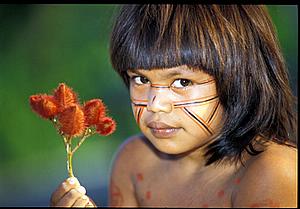 The children had half a day of school and half a day of learning
how to work like their parents, in whatever was their speciality.
The best hunters or fisherman got the best and most desirable woman
as wives. I asked why no one seemed to wear glasses or have bad
hearing? – The answer was simple nobody would marry anyone with
those problems and therefore they were bred out – Survival of the
fittest! Adam's words echoed round my brain, “Lucky you
were born in London Tony”.
The children had half a day of school and half a day of learning
how to work like their parents, in whatever was their speciality.
The best hunters or fisherman got the best and most desirable woman
as wives. I asked why no one seemed to wear glasses or have bad
hearing? – The answer was simple nobody would marry anyone with
those problems and therefore they were bred out – Survival of the
fittest! Adam's words echoed round my brain, “Lucky you
were born in London Tony”.
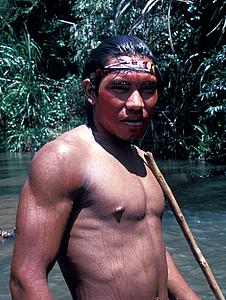 Antonio looked after the canoes and water transport; the tribe
would have its own specialists just as we do in our world. The
Chief himself would deal with the outside world business. The
Marriage with outsiders was not encouraged, The 'Yawanawa'
did not want Aids to in filter the village and also when a non
Indian married one of their girls, they tended to take the bride
out of the tribal area to live.
Antonio looked after the canoes and water transport; the tribe
would have its own specialists just as we do in our world. The
Chief himself would deal with the outside world business. The
Marriage with outsiders was not encouraged, The 'Yawanawa'
did not want Aids to in filter the village and also when a non
Indian married one of their girls, they tended to take the bride
out of the tribal area to live.
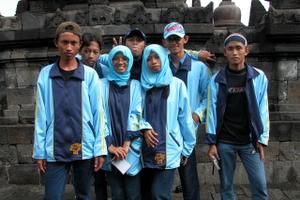

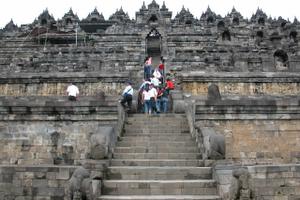 Early morning is the best time to visit Javanese temples, Borobudur
included. The gate opens at 6 am, around sunrise. The view of the
surrounding volcanoes and the Bukit Menoreh range to the south is
clearest at dawn, although morning mists sometimes obscure the view
until 8 am. Visitors must walk 500 meters to the base of the hill
then climb a series of steps to reach the temple foot. To see all
the reliefs one must walk more than 2 km (1.25 mile) around the four
galleries and climb several flights of steps. The minimum amount of
time needed at the Site is 1.5 hours.
Early morning is the best time to visit Javanese temples, Borobudur
included. The gate opens at 6 am, around sunrise. The view of the
surrounding volcanoes and the Bukit Menoreh range to the south is
clearest at dawn, although morning mists sometimes obscure the view
until 8 am. Visitors must walk 500 meters to the base of the hill
then climb a series of steps to reach the temple foot. To see all
the reliefs one must walk more than 2 km (1.25 mile) around the four
galleries and climb several flights of steps. The minimum amount of
time needed at the Site is 1.5 hours.